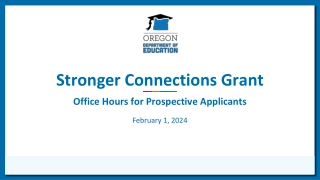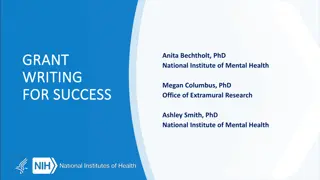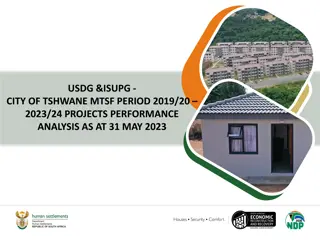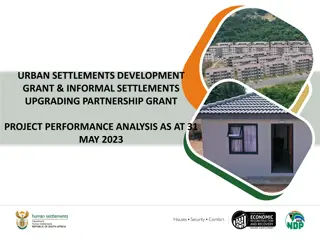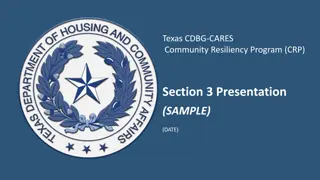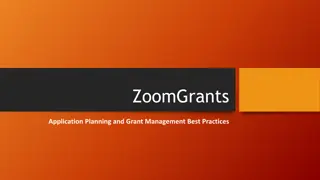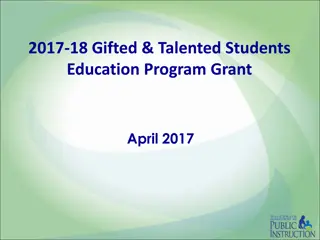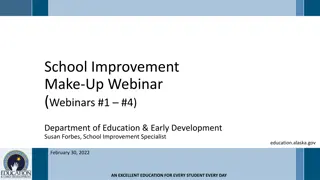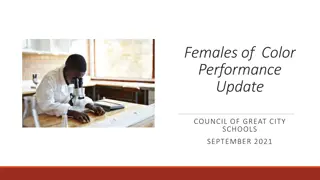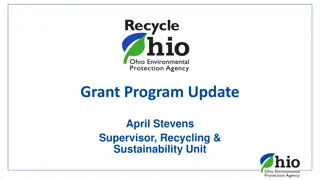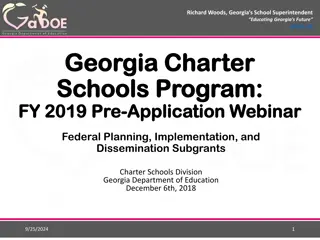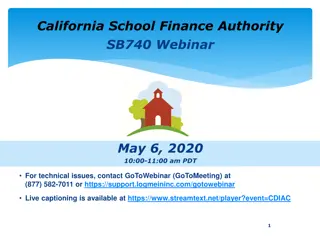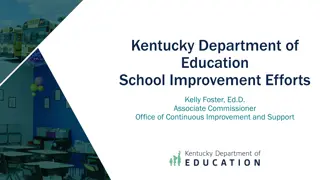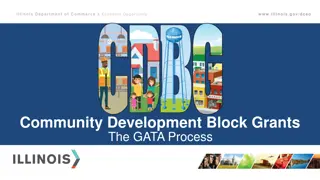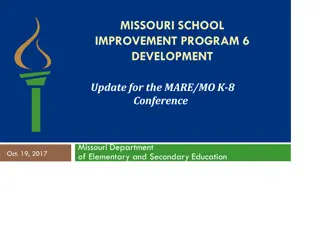Analysis of School Improvement Grant Program Performance in Great City Schools
This analysis focuses on trends in school performance in the United States regarding the School Improvement Grant (SIG) program under the American Recovery and Reinvestment Act of 2009. It compares schools that received SIG awards with SIG-eligible and non-SIG-eligible schools, examining changes in student proficiency in math and reading across different academic years. The study aims to assess the impact of SIG funding on school performance and provides insights into improvements made by schools in different categories.
Uploaded on Sep 15, 2024 | 0 Views
Download Presentation

Please find below an Image/Link to download the presentation.
The content on the website is provided AS IS for your information and personal use only. It may not be sold, licensed, or shared on other websites without obtaining consent from the author. Download presentation by click this link. If you encounter any issues during the download, it is possible that the publisher has removed the file from their server.
E N D
Presentation Transcript
The School Improvement Grant Program: Analysis of Performance in America s Great City Schools Council of the Great City Schools Fall 2014
Purpose Examine trends in performance for schools across the country that received SIG awards as part of the American Recovery and Reinvestment Act of 2009 (ARRA) Analyze performance for schools receiving grant awards (SIG Award Schools) compared with: SIG Eligible Schools those schools deemed eligible for SIG awards, but not receiving any funding in Cohort 1 or Cohort 2 of the award cycle; Non-SIG Eligible Schools those schools across the country not eligible for SIG funding due to higher levels of student achievement.
Methodology Grades 3-8 Trends Change in Percentage of Students At or Above Proficient Percentage of Schools Increasing the Percentage of Students At or Above Proficient by level of improvement: No Improvement 1% to 4%, 5% to 9%, 10% or more Change in Percentage of Students Below Basic 2012-2013 Sample 13 CGCS States 21 CGCS Districts States were excluded based on three criteria: 1. Fall Testing Dates 2. Changes in State Assessments (Content and/or Cut Scores) 3. No Data or Poor Data Quality
Percentage of Students Proficient in Math by School Type, Pre & Post SIG Funding 80% Percentage of Students At or Above 68.1% 68.0% 66.8% 70% 64.6% 60% Proficient 50% 52.9% 52.7% 51.7% 49.1% 40% 38.1% 38.0% 30% 33.4% 27.4% 20% 09-10 - Baseline 10-11 11-12 12-13 Academic Year SIG Awarded Schools (n=173) Random Sample of SIG Eligible and Non-Awarded Schools (n=626) Random Sample of Schools Across the State (n=984)
Percentage of Students Proficient in Reading by School Type, Pre & Post SIG Funding 67.4% 67.3% 70% 66.1% 64.7% Percentage of Students At or Above 65% 60% 55% 51.4% 51.4% 49.2% 47.5% 50% Proficient 45% 40% 35% 37.6% 36.9% 33.8% 30% 30.6% 25% 09-10 - Baseline 10-11 11-12 12-13 Academic Year SIG Awarded Schools (n=181) Random Sample of SIG Eligible and Non-Awarded Schools (n=628) Random Sample of Schools Across the State (n=986)
Percentage of Schools Improving in Mathematics by Category and School Type, 2010 to 2013 60% 56.9% 50% 45.9% Percentage of Schools Improving 40% 35.6% 34.5% 30% 27.6% 27.0% 27.0% 20.7% 20.0% 19.6% 18.0% 20% 16.7% 14.9% 14.7% 12.2% 8.8% 10% 0% No Improvement Less Than 5 Percentage Point Improvement 5 to 10 Percentage Point Improvement Greater than 10 Percentage Point Improvement Random Sample of Schools Across States (n=986) Random Sample of SIG Eligible Non-Award Schools (n=627) Non-CGCS SIG Award Schools (n=102) CGCS SIG Award Schools (n=74)
Percentage of Schools Improving in Reading by Category and School Type, 2010 to 2013 40% 45% 38.8% 35.1% 35% 31.5% Percentage of Schools Improving 29.9% 30.0% 30% 24.2% 24.7% 24.3% 25% 23.4% 22.6% 22.1% 21.7% 21.6% 19.4% 20% 17.5% 15% 13.2% 10% 5% 0% No Improvement Less Than 5 Percentage Point Improvement Random Sample of Schools Across States (n=989) Random Sample of SIG Eligible Non-Award Schools (n=628) Non-CGCS SIG Award Schools (n=103) CGCS SIG Award Schools (n=77) 5 to 10 Percentage Point Improvement Greater than 10 Percentage Point Improvement
Percentage of Students Below Basic in Math by School Type, Pre % Post SIG Funding 45% Percentage of Students Below Basic 40% (Lowest Performance Level) 41.9% 35% 35.9% 30% 31.9% 31.7% 25% 24.1% 23.0% 22.6% 20% 22.0% 15% 16.4% 15.3% 14.7% 14.4% 10% 09-10 - Baseline 10-11 11-12 12-13 Academic Year SIG Awarded Schools (n=156) Random Sample of SIG Eligible and Non-Awarded Schools (n=535) Random Sample of Schools Across the State (n=686)
Percentage of Students Below Basic in Reading by School Type, Pre & Post SIG Funding 35% 33.7% Percentage of Students Below Basic 30% (Lowest Performance Level) 30.5% 27.5% 27.5% 25% 22.6% 21.5% 19.9% 19.6% 20% 15% 13.0% 13.0% 12.5% 11.8% 10% 09-10 - Baseline 10-11 11-12 12-13 Academic Year SIG Awarded Schools (n=156) Random Sample of SIG Eligible and Non-Awarded Schools (n=537) Random Sample of Schools Across the State (n=687)
Purpose The Council of the Great City Schools examined how member districts were implementing School Improvement Grants (SIG) that were funded through the American Recovery and Reinvestment Act of 2009 (ARRA). What were the effects of the program on student achievement? Districts were chosen for case studies based on state test scores in math and reading, following an analysis of Cohort 1 data. Some districts were chosen because they showed increases in scores; others were chosen because they showed no changes or decreases. The Council s research team interviewed central-office staff and school-based personnel who were involved in the design and/or implementation of the grant between 2009- 2013.
Research Questions The research team was interested in the following research questions What was the political and organizational context of the district during the SIG implementation? What were the districts instructional areas of focus during the study period? What were the school goals and objectives beyond state and district objectives during that period, and what was the process for setting those goals? What kind of interventions were put in place to improve academic performance in the SIG schools? How were the grant-funded schools held accountable for student achievement? What measures were used? What professional development was available for teachers and administrators to address the academic needs of students and special populations performing poorly? What are school and district plans for sustaining programs and processes implemented with SIG funding? 1. 2. 3. 4. 5. 6.
Districts Interviewed Cleveland Columbus Denver Miami-Dade County Milwaukee Philadelphia San Francisco Seattle
Political and Organizational Context Post SIG, respondents reported that there were: Many schools that developed turnaround plans Inconsistent initiatives across buildings--few districts developed cohesive plans to address the needs of all SIG schools Schools were often siloed within the districts Turnaround schools could opt out of district curriculum Inconsistent performance Little consistent direction or organization across schools State intervention was irregular and often not coordinated with the district. Prior to SIG, respondents reported that there were: Few support structures in place for low performing schools No clear direction or organization Frequent changes in leadership, and Few high-quality interventions in the lowest performing schools.
Goals and Objectives School goals included: Building a strong support team Building teacher buy-in and ownership throughout the turnaround process Becoming better users/consumers of data Improving student achievement Building relationships with the community Improving parent engagement Improving school climate and morale Increasing student attendance and decreasing student suspension rates Setting higher expectations for students by increasing the rigor of instruction Enhancing curriculum materials Providing professional development on instructional practices and data uses
Staffing Districts used SIG funding to address personnel concerns: Hiring turnaround principals Working with teacher unions to: Manage staff turnover process ensuring low performing schools attracted high quality teachers, and Extend school days and professional development hours while working on a joint understanding of the unique needs of low performing schools. Developing unique administrative structures to support low performing schools (i.e., specific school regions or chancellors district -like structures ) Hiring: instructional supervisors/coaches reading and math specialists social workers/counselors Engaging parents and the community Ensuring the fidelity of grant implementation
Interventions Schools targeted grant funds on student learning by: Increasing school partnerships with community organizations AVID City Year College Summit Teach for America Peace Corps Communities in Schools Reducing class sizes Hiring part-time tutors to support struggling students Implementing a new and more rigorous curriculum--often with a literacy focus Extending school-day time Adding after-school, intercession, and summer enrichment programs Providing incentives for teachers to improve student performance Increasing professional development hours for teachers
Professional Development Schools supported staff by: Providing extensive professional development to support SIG initiatives Focusing on data use Developing an embedded professional development model, e.g., co-teaching with veteran or strong teachers Improving tools to support teachers (i.e., dashboards, planning tools, etc.) Allotting time for feedback from teachers and other school leaders Increasing professional development hours with an emphasis on job-embedded support
Accountability States and districts held schools accountable by: Conducting classroom walkthroughs with school, district, and state leaders But there was inconsistent implementation within buildings And classroom observations were less punitive and more informative and supportive Using assessments to improve classroom instruction and determine interventions in addition to teacher evaluations Implementing more focused weekly supports and review systems in low performing schools
Challenges and Opportunities Opportunities Districts and schools may continue to: Foster partnerships with organizations to support schools Collaborate with central office staff and seek support Focus on data to inform instruction Engage parents and the community Provide support to teachers through professional development. Challenges Grant was a temporary solution for larger systemic issues lack of high quality intervention programs difficulty recruiting and retaining high quality teachers Loss of staff that were hired through SIG Once funding is gone, few plans for support remained across school buildings from district and state leaders
When It Worked and When It Didnt When It Worked A clear coherent districtwide plan for turning around low performing schools. Central office supported low performing schools. Schools provided flexibility in making staff changes/removing poor performing teachers. Well coordinated and targeted interventions and supports for struggling students. Leveraging data to identify professional development for teachers. Teachers had clear understanding of challenges and commitment needed to succeed. When It Didn t Disconnected districtwide plans that often resulted in the lack of a coordinated strategy. State and central office administrators focused on grant compliance, not coordination. Redundant or contradictory state and local intervention efforts Schools had difficulty removing poor performing staff or hiring stronger teachers. Excess flexibility for the capacity of the school. Little evaluation of intervention efforts, and/or leaders were not always clear about the benefits of intervention programs. Weak instructional interventions 25



